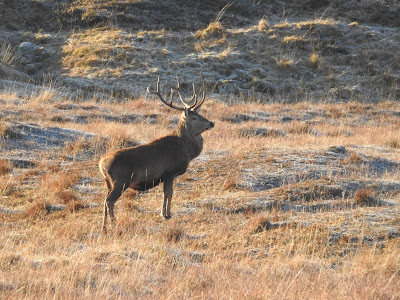January 2024
January 2024 started with our weather being dominated by a large high pressure system, which brought very cold temperatures (down to -10c), but very calm windless conditions and lovely blue skies for almost 2 weeks, turning the Highlands into a real 'winter wonderland', and although you had to wrap up warm, it was almost perfect for wildlife-watching. However...... things changed from mid-month, when, apart from a couple of decent days, low pressure systems brought us heavy snow for a week, followed by milder, but much windier, wetter conditions as a result of named storms Isha and Jocelyn, which made wildlife watching considerably more demanding......
The days are lengthening noticeably now, with up to 8-9 hours of usable daylight, and dawn (for the Black Grouse) is still a relatively sociable 7:30-8:00 am, with dusk at around 5pm.
Full-day local safari bird lists usually top-out in the 30's or 40's at this time of year, though a trip to the nearby (one hour by car ) Moray Coast can boost this total considerably, whilst mammal day lists can vary between 3 and 8 species, depending on the time of our start and number of habitats visited, with early starts usually proving to be best.
To give you an idea of what you may realistically hope to see if you are considering a future January visit, I hope the following more detailed information, illustrated with photos taken at sites in and around the Cairngorms National Park, and sometimes further afield, by myself, my friends or my safari clients this month and in previous January's will help....clicking on the picture enlarges it to full-screen.
Local speciality/upland bird species seen regularly during the month included:
Crested Tit, Red Grouse, Goldeneye and Dipper, whilst Black Grouse were occasionally seen at or soon after dawn at traditional lek sites, and we also had a few decent sightings of Golden Eagle.........
Local winter visiting birds were represented by a few Redwings and Fieldfares, family groups of Whooper Swans, several species of 'grey' Geese, and large flocks of Redpolls were spotted too...with Waxwings being seen locally on and off throughout the month, though Bramblings seem to be very few and far between again this winter....
Mammal species seen regularly included:
Red Squirrel, Red Deer, Reindeer, Roe Deer, Rabbit and (white) Mountain Hare.....with just a couple of (mainly dawn) views of Brown Hare , and a few brief glimpses of Wood Mouse and Bank Vole underneath bird feeders....whilst sadly, our local feral Mountain Goats proved to be very elusive....
January 2024 bird sightings in more detail:
Up on the moors....
Black Grouse are one of my favourite local speciality birds, and always prove popular with my safari clients, especially from January to May when they often display and lek at dawn. However, our early morning visits to their traditional 'lek' sites gave 'patchy' results this month, with a few 'no shows' offset by up to 6 cock birds showing beautifully on one occasion...please be aware though, that they are easily 'spooked' and are legally protected from disturbance, so we have to keep a respectable (and lawful) distance away...
 |
| Displaying Black Grouse |
 |
| Displaying Black Grouse |
Still on the moors, and later in the day, the Red Grouse are becoming a little easier to see each week now, as the cock birds become ever bolder, often posturing aggressively from a raised position, and calling 'go-bak, go- bak' loudly to establish a territory and attract a mate, often with their red 'eyebrows' bulging impressively.
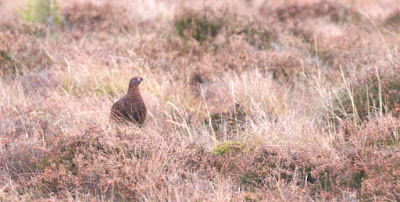 |
| Male Red Grouse by Bob Smith |
 |
| Female Red Grouse |
 |
| Red Grouse - Photo from Jan 2015 |
Upland moorlands can also produce bird of prey sightings, and this month we were lucky enough to see Kestrel, Common Buzzard, and Red Kite reasonably frequently, and although we didn't see it, a Rough-Legged Buzzard was also reported.....
Up in the glens...

A spectacular local upland glen
Although sightings of Eagles were a little less frequent when compared to the usual annual peak viewing time of October-December, both Golden Eagle and White-Tailed Eagle were reported in favoured local glens this month, and although a sighting of WTE still eludes me personally, It was great to get my 'year-tick' of a 'Goldie' , always an awesome sight, even though it was some distance away.......
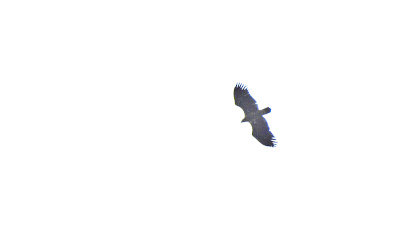 |
| Golden Eagle |
 |
| Golden Eagle - Photo from Jan 2023 |
 |
| Golden Eagle by Bob Smith - Photo from Jan 2022 |
 |
| Golden Eagle by Steve Nicklin - Photo from Jan 2019 |
 |
| White-Tailed Eagle with Buzzard - Photo from Jan 2023 |
Should the Eagles fail to show, the regular 'raptor back-up cast' of Kestrel, Sparrowhawk, Buzzard , Red Kite, and even the occasional Hen Harrier should not be forgotten though, as all were seen and enjoyed at least once this month, though Goshawk, Merlin and Peregrine have still yet to be encountered on my safaris this year...
 |
| Male Sparrowhawk - Photo from Jan 2019 |
 |
| Red Kite |
 |
| Common Buzzard by Bob Smith |
In the forests...

A local ancient Caledonian Forest
In the Caledonian pine forests, although we did have a few 'no-shows', our local Crested Tits occasionally showed well at my favourite forest feeding stations, especially soon after sunrise, and particularly on the colder days, when they are presumably at their most desperate for food, with several of my delighted safari clients seeing them for the first time, though a decent photo eluded us.....
 |
| Crested Tit by Bob Smith - Photo from Jan 2022 |
 |
| Crested Tit by Bob Smith - Photo from Jan 2019 |
 |
| Crested Tit by Bob Smith - Photo from Jan 2023 |
It is well worth noting that the winter months (October-February) are actually the best time of year for seeing the 'wee Cresties', as these characterful little birds can be frustratingly secretive and unobtrusive during the breeding season, with sightings being much more difficult to obtain between March and September....
Crossbills however, were actually reasonably cooperative this month, and although the vast majority of sightings were still 'fly-overs', with it being breeding season, we also managed a few decent views of perched birds singing too...
 |
| Female Crossbill by Bob Smith |
 |
| Male Crossbill by Bob Smith |
 |
| Male Crossbill - Photo from Jan 2020 |
Sadly, despite many hours spent and miles walked in local Caledonian forests this month, not a single 'chance' Capercaillie sighting was achieved, and sadly, I didn't even find any of their distinctive cigarette shaped poos formed mainly of pine needles, to give me any hope or encouragement .......
Please note that Capercaillie numbers would still appear to be declining alarmingly, they are now very rare (possibly down to the last couple of hundred) and elusive, and I would only rate our chances of seeing one on my safaris as "very slim" at best, and we are now being asked not to go in search of them at dawn in the spring lekking season - see link below:
Lek It Be - Cairngorms Capercaillie Project
A bonus by-product of regular winter feeding is often (especially on colder days) being able to feed the incredibly confiding Coal Tits and (sometimes) Great Tits by hand, an experience much enjoyed by my safari clients of all ages...
 |
| Hand feeding a Coal Tit |
On the rivers...
Our local Dippers are now most definitely in territorial mode, and we were lucky enough to see them posturing and displaying and sometimes singing their distinctive 'scratchy' song from a prominent rock on several occasions, often near a bridge, where they are likely to nest...
 |
| Dipper |
 |
| Dipper by Bob Smith - Photo from Jan 2020 |
On the lochs...
Though they were frozen and almost devoid of birds for the first 2 weeks of the month, star birds on the lochs during the winter are probably Goldeneyes, with the males now in their dapper breeding plumage, and some even seen performing their elaborate 'head-banging' courtship displays, and the winter-visiting Whooper Swans, with a back up cast of grey Geese, Goosander, Teal, Wigeon and Tufted Ducks.
 |
| Whooper Swans |
 |
| Male Goldeneye by Steve Nicklin - Photo from Jan 2021 |
On the marshes...
 |
| Ring-Tail Hen Harrier - Photo from Jan 2023 |
Up in the mountains....
Snow Buntings can often be seen well during the winter as they usually begin to frequent known lower altitude sites, possibly driven down from the mountain tops by the snow and cold, and with their numbers likely to have been swelled by visitors from Scandinavia...and I am always sure to have a bag of wild bird seed on board, as they can sometimes be tempted to come and feed at quite close range....as was the case several times during the first half of this month....
 |
| Snow Buntings by Bob Smith |
 |
| Snow Buntings |
 |
| Snow Bunting by Karen Weissmann - Photo from Jan 2023 |
With the Cairngorm Funicular Railway still closed for repairs, the weather rarely being suitable , and the days so short now, I didn't venture up into the mountain-tops myself this month, but for future reference, a few Ptarmigan , still almost totally white, can sometimes be seen, up around the 'snow-line', usually sheltering on the leeward sides of ridges, out of the cold wind...
On farmland....
 |
| Typical local farmland |
Although all the waders are still at the coast now - but due to return soon - 'grey' Geese and Whooper Swans can often be seen feeding on crop remains , whilst the seeds on local farmland during the autumn and winter months often attract large flocks of mixed finches and buntings, along with the winter thrushes and more common Pheasants and occasional Red-Legged Partridges...........
 |
| Greylag Geese |
 |
| Red-Legged Partridges |
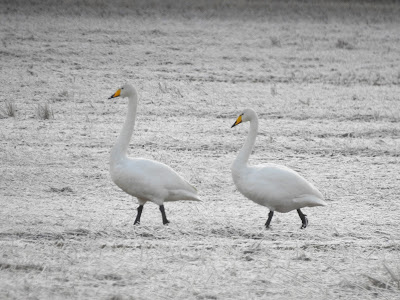 |
| Whooper Swans |
In local gardens...
Berry bushes, fruit trees and garden bird feeding stations are a real magnet for hungry winter visiting birds from further north, and Redwings, Fieldfares Bramblings and Redpolls were all seen locally alongside the more common tits and finches, and we continued to enjoy our first proper 'invasion' of Waxwings for some years, with my own garden in Aviemore having up to 40 of these fantastic birds feeding on sliced apples on the lawn on and off throughout the month...
 |
| Lesser Redpoll |
 |
| Male Brambling - Photo from Jan 2021 |
 |
| Waxwings |
 |
| Waxwings |
 |
| Waxwing |
 |
| Waxwing |
Other good/scarce birds seen/reported locally this month included:
 |
| Great Grey Shrike |
A few photos of more common birds seen locally this month:
 |
| Lesser Redpoll and Siskin by Bob Smith |
 |
| Treecreeper by Bob Smith |
 |
| Coal Tit |
 |
| Greenfinch |
 |
| Greater Spotted Woodpecker by Bob Smith |
Adventures 'out of area':
The nearby Moray Coast is always worth a visit, especially in autumn and winter, and a couple of visits gave us a good selection of auks, waders, wildfowl, seaducks, geese , swans and gulls , and a couple of rarities in the form of an American Wigeon and a male Smew.....
 |
| Sanderlings by Bob Smith |
 |
| Ringed Plovers by Bob Smith |
 |
| Oystercatcher |
 |
| Male Goosander |
 |
| American Wigeon by Bob Smith |
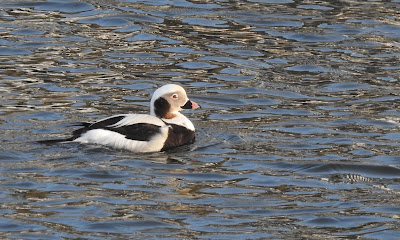 |
| Male Long-Tailed Duck |
 |
| Male Eider |
The freshwater lochs and nature reserves just inland from the Moray Coast can be productive too....
 |
| View from Loch Spynie hide by Bob Smith |
 |
| Male Smew |
January 2024 mammal sightings in more detail:
Star mammal for January is usually that much sought-after local speciality the Mountain Hare, and rightly so, as Britain's only native 'lagomorph' and with their UK distribution being restricted to just a few remote upland areas, seeing one is always a treat.
 |
| Mountain Hare |
 |
| Mountain Hare |
 |
| Mountain Hare by Steve Nicklin - Photo from Jan 2018 |
Seeing them was actually easier said than done for the first half of the month though, with the heavy snow making the job of finding a white animal on a white background pretty tricky, with using a thermal imager, or following their pawprints in the snow proving to be the best methods of finding them...
It should be noted though, that most of our views are at range through my telescope, and that a closer view or photo opportunity usually involves some considerable rough uphill walking, often in deep snow....
In the same upland glens, Red Deer, mainly in large same-sex herds, can usually be seen, although a number of factors such as the weather, in particular the wind strength and depth of the snow, and whether there is any local shooting activity , can dictate whether we get nice close-up views, or distant views through the telescope....
Still up in the glens, another local speciality mammal, our Feral Mountain Goats can often seen on the same sheltered sides of the ridges as the Red Deer , and, although we struggled to see them this month, at this time of year it is not unusual to see them with the first , very cute, new-born youngsters ....
 |
| Feral Mountain Goats - Photo from January 2020 |
Red Squirrels are a true Highlands speciality, and we are usually fortunate enough to see at least one on most of my safaris, mainly chomping on peanuts at forest feeding stations, but with the occasional random sighting whilst walking or driving in suitable forest habitat.
Roe Deer are most commonly seen at dawn or dusk and generally at the quieter, more remote sites well away from human disturbance, their shy, nervous nature making them much harder to see than Red Deer, despite being considerably more numerous and widespread than their larger 'cousins'...
Hairy Highland Coo's always prove to be popular with my safari clients, especially those who do not have them close to home, so don't be afraid to ask me if you fancy going to see them, and maybe even get to feed and 'pat' them, as I have a couple of great sites....
Rare/nocturnal mammals:
I get a few enquiries about the possibility of seeing Badgers and Pine Marten from my safari clients, many of whom I suspect are unaware that they are actually a largely nocturnal creature, and although we do get the occasional (maybe one or two a year) dawn glimpse of one, you would definitely have a much higher chance of seeing them at a specific dusk Badger/Pine Marten watching hide - Please contact me for more information.
Similarly, our inland Otters too are mainly active during the hours of darkness, and again, although we do get a few early-morning sightings on local lochs and rivers each year, including one on the 10th of this month, looking for them feeding in a suitably quiet, kelp - filled bay on the coast on a rising tide, but at any time of day, would give you a much better chance.
Whilst we are still on the 'tricky to see stuff', the Scottish Wildcat too, as well as being incredibly rare now, is also generally nocturnal, and the fact that I have had a mere handful of (dawn or dusk) sightings in 19 years of providing wildlife safaris should give you an idea of how difficult they are to see.
Other wildlife:
I don't recall seeing any 'other wildlife' this month....
 |
| Nice light through pine trees |
News:
I am very pleased to announce that Highland Wildlife & Birdwatch Safaris has recently been awarded - for the second consecutive year - a Travelers Choice accreditation from Trip Advisor, for being ranked in the top 10% of visitor attractions worldwide based on customer reviews and feedback.
This achievement would not have been possible without the support of all my family, friends, safari clients, social media followers, regular blog readers , the Visit Scotland 'mystery shoppers', and everyone else who has helped and encouraged me along the way to ‘living my dream’ of being a wildlife safari guide, since 2004, especially over the last few very difficult COVID affected years, so a big THANK YOU to you all :)
All tourism/hospitality/activities in Scotland are open , are free of restrictions and I have now completed two years of (thankfully!) increasingly busy and extremely enjoyable safaris with clients with no major issues arising.
With all national travel restrictions lifted too, Scotland is officially 'open for business' for visitors from all over the UK, and from abroad.
For those considering a visit, these wildlife/outdoor tourism websites may prove useful:
June - September is midge season - But thankfully, this area is not usually affected too badly - This link explains why:
Bumper midge hatch alert after warm spell - BBC News
https://www.gov.scot/collections/coronavirus-covid
NatureScot (outdooraccess-scotland.scot)
Can Nature Help Health? | Nature Prescriptions - YouTube
Scotland, Yours to Enjoy. Responsibly. - YouTube
Cairngorms National Park Authority
Positive prescriptions | The RSPB
COVID-19
The Scottish Highlands, being very sparsely populated, has had very few COVID-19 cases in comparison to most of the UK, and on my safaris we tend to visit remote , wild habitats well away from the more popular tourist areas, and usually have very little interaction with other people, and this is something that I intend to continue.
 |
| A frozen local loch |
Summary:
Although I was only booked for 2 safaris this month - sadly, January is always 'quiet' - I am pleased to report that I managed to get out and about in the wilds to enjoy the spectacularly scenery and wildlife of the Cairngorms National Park on a regular basis with friends and family, not so good for my bank balance, but great for my physical and mental health, general well-being , and my ever-increasing 2024 bird 'year-list', and thankfully, my safari bookings diary is filling - up nicely for future months....
 |
| A frosty dawn scene |
Reviews:
https://www.tripadvisor.co.uk/Attraction_Review-g186537-d3335134-Reviews-
 |
| Nice winter light through a frosted tree |
Gift Certificates:
| Safari gift voucher |

















